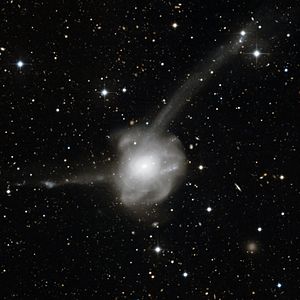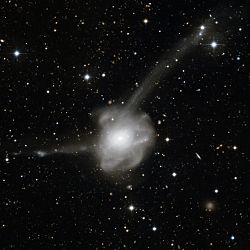NGC 7252
| Galaxie NGC 7252 | |
|---|---|
 | |
| Aufnahme mit dem Wide Field Imager (WFI) am La-Silla-Observatorium | |
| AladinLite | |
| Sternbild | Wassermann |
| Position Äquinoktium: J2000.0, Epoche: J2000.0 | |
| Rektaszension | 22h 20m 44,7s[1] |
| Deklination | -24° 40′ 42″[1] |
| Erscheinungsbild | |
| Morphologischer Typ | (R)SA(r)0^0^: /HII[1] |
| Helligkeit (visuell) | 11,1 mag[2] |
| Helligkeit (B-Band) | 12,1 mag[2] |
| Winkelausdehnung | 2,1′ × 1,7′[2] |
| Positionswinkel | 119°[2] |
| Flächenhelligkeit | 12,3 mag/arcmin²[2] |
| Physikalische Daten | |
| Zugehörigkeit | LGG 457[1][3] |
| Rotverschiebung | 0,015984 ± 0,000003[1] |
| Radialgeschwindigkeit | (4792 ± 1) km/s[1] |
| Hubbledistanz vrad / H0 | (217 ± 15) · 106 Lj (66,5 ± 4,7) Mpc [1] |
| Geschichte | |
| Entdeckung | William Herschel |
| Entdeckungsdatum | 26. Oktober 1785 |
| Katalogbezeichnungen | |
| NGC 7252 • PGC 68612 • ESO 533-015 • MCG -04-52-036 • IRAS 22179-2455 • 2MASX J22204475-2440420 • SGC 221758-2455.8 • Arp 226 • AM 2217-245 • GC 4780 • H III 458 • h 3934 • PRC D-35 | |
NGC 7252 = Arp 226 ist eine Linsenförmige Galaxie vom Hubble-Typ SA0 im Sternbild Wassermann auf der Ekliptik, die schätzungsweise 220 Millionen Lichtjahre von der Milchstraße entfernt ist. Halton Arp gliederte seinen Katalog ungewöhnlicher Galaxien nach rein morphologischen Kriterien in Gruppen. Diese Galaxie gehört zu der Klasse Galaxien mit amorphen Spiralarmen. Die Galaxie wird auch Atome für den Frieden-Galaxie bezeichnet, da sie fast so aussieht wie ein Atom um welches die Elektronen kreisen. Der Ausdruck stammt von der Atoms for Peace-Rede des amerikanischen Präsidenten Eisenhower von 1953.
Das Objekt wurde am 26. Oktober 1785 von William Herschel entdeckt.[4]
Die Galaxie NGC 7252 aufgenommen vom Hubble-Weltraumteleskop
Weblinks
- Galactic politics (engl.)
- Arp Atlas of Peculiar Galaxies
- SIMBAD Query
- astronews.com: Eindrucksvoller Blick auf galaktische Kollision 11. November 2010
- ESO: Wenn zwei Galaxien aufeinander treffen +Fotos,Karte&Animationen - 10. November 2010
- ESO: VLT erstellt Karte des Gases in der Minispirale NGC 7252 - 5. Februar 2018
- astronews.com: Bild des Tages 8. Dezember 2015
- Seligman Arp
- Capella Observatory
Literatur
- Jeff Kanipe und Dennis Webb: The Arp Atlas of Peculiar Galaxies – A Chronicle and Observer´s Guide, Richmond 2006, ISBN 978-0-943396-76-7
Einzelnachweise
Auf dieser Seite verwendete Medien
Autor/Urheber: ESO, Lizenz: CC BY 4.0
This new image shows the results of a vast collision between two galaxies. This strange object is known as NGC 7252, or Arp 226, and has the odd nickname Atoms-for-Peace. The picture was taken by the Wide Field Imager on the MPG/ESO 2.2-metre telescope at ESO’s La Silla Observatory in Chile. It is a combination of exposures taken through blue and red filters, for a total exposure time of more than four hours. The field of view is about 18 arcminutes across.
Autor/Urheber: NASA & ESA, Acknowledgement: Judy Schmidt (Geckzilla), Lizenz: CC BY 4.0
The stunning Atoms for Peace galaxy was given its nickname due to its superficial resemblance to an atomic nucleus, surrounded by the loops of orbiting electrons. “Atoms for Peace” was the title of a speech given by President Eisenhower in 1953, in an attempt to rebrand nuclear power as a tool for working toward global peace. Somewhat ironically this galaxy has had anything but a peaceful past — it was formed in a catastrophic merger between two smaller galaxies nearly 1 Gyr ago.


